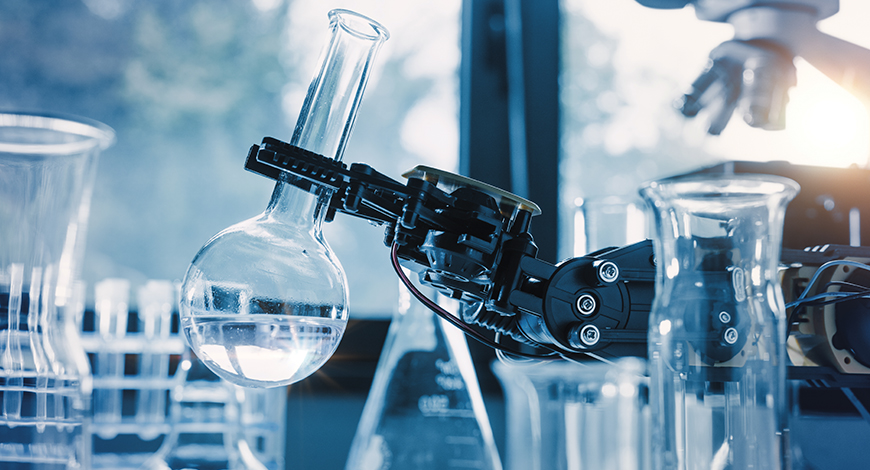Industry
Amplifying the power of automation

Automation in a laboratory continues to require humans to perform maintenance, regulate the different machines through physical observation, and above all assume full responsibility for the results.
Laboratory automation has seen substantial growth in the last few decades, with an increasing range of automated functions and modular options in the lab automation market. Although the initial driver may have been cost savings, opportunities to reduce turnaround time and increase reproducibility, quality, and safety are becoming increasingly apparent.
Covid-19 accelerated the adoption of digital and remote research technologies in clinical diagnostics. Many businesses had to pivot to virtual research methods due to social distancing measures, and this highlighted the importance of having flexible and adaptable research technologies in place.
With automation solutions, labs eliminated the most repetitive tasks, such as library preparation or liquid handling, that have typically been performed manually by lab technicians or scientists. And, as the technology advances, more and more complex processes, and even whole workflows, can be automated.
Busy laboratories faced increasing pressures to improve both throughput, efficiency and quality, while their resources and manpower were often stretched to the absolute limit. The need to manage complex tests, multiple workflows and time-consuming sample preparation presented significant challenges to labs of all shapes, sizes, and specialities. Lab automation helped to standardize tests.
Whether a single piece of equipment, such as a pipette machine or automatic aliquoting machine, or a full workflow automation, lab automation proved to be a gamechanger for these labs.
The hospital laboratories are increasingly adopting RFID technology for laboratory automation systems due to its better productivity and product quality, reduced costs for technology, error reduction, faster delivery of samples, and reduced human intervention.
Those healthcare companies that adopted RFID-enabled laboratory automation systems, found errors minimized by 70 percent, efficiency and patient safety maximized, and specimen turnaround time reduced by 50 percent.
Comprising clinical laboratory machines, equipment, and instruments, the main systems are automated liquid handling, microplate readers, standalone robots, automated storage and retrieval systems, software and informatics, and other equipment. The microplate reader is an instrument that is used to measure biological, chemical, or physical reactions of analytes within the wells of the microplate.
Increased demand for microbiology testing and standardization of sample-collection devices for microbiology culture has driven the adoption of automated laboratory systems for culture-based laboratory testing in clinical microbiology.
There remains a severe shortage of skilled and trained healthcare professionals for operating the advanced laboratory equipment, which requires specialized skillsets. This is expected to be a major restraint on the market. Forty percent of the healthcare industry is facing difficulties in hiring process development staff due to a shortage of talent.
Total lab automation is popular for drug discovery, clinical diagnostics, genomics solutions, and proteomics solutions. The end users are largely biotechnology and pharmaceutical industries, research institutes, hospitals, private labs, and academic institutes. Drug discovery is expected to be the largest application segment, and pharmaceutical and biotechnology companies the larger end userm when compared to academic and research institutes.
Major players in the laboratory automation systems market are Tecan Group, Perkinelmer, Thermo Fisher Scientific, Agilent Technologies, Danaher, Qiagen, Roche, Abbott, Siemens, and Eppendorf. North America was the largest region in the laboratory automation systems market in 2022, and Western Europe the second largest.
The global laboratory automation systems market is estimated at USD 5.87 billion in 2022, with a CAGR of 6.4 percent. In the period 2023 to 2026, expected CAGR is 4.1 percent. The growth rate for lab automation in the life sciences industry is greater. Comprising robotics, software, data processes, and other technologies, this market is expected to reach USD 8.84 billion by 2027, at a CAGR of 7.69 percent.
The popular laboratory automation include:
Closed automation system. This is an automation system, in which all equipment utilized comes from the same manufacturer. The analysis method in a closed automation system is usually governed by the recommendations of the manufacturer who made the product. This type of automation is also called a closed-loop automation system.
Open automation system. The analysis methods for the automation types and total laboratory automation.
Total laboratory automation. This automation occurs when a laboratory completely replaces human actions with machines and automated processes. Total laboratory automation can pave the way for multiple forms of automatic analysis. For example, an autoanalyzer machine can run tests on various samples or specimens in a short period. The two main types of multiple-specimen tests are continuous flow and sequential. Continuous flow tests can analyze multiple specimens at once. Sequential tests examine the samples one at a time. However, the delay from having to place each specimen in its original place manually is eliminated.
Partial laboratory automation. Only some laboratory processes are replaced with machines in partially automated laboratories. The results from these types of tests are not as verifiable as those from total laboratory automation. They have a possibility of human error much higher than those from totally automated laboratories. Discrete analysis has to be performed instead of using autoanalyzer machines. A discrete analysis is a test in which each reaction part is handled separately.
It may seem that partial laboratory automation is inferior to total laboratory automation. However, there are some benefits. Short-term costs are lesser for partial laboratory automation, which may be more critical for smaller laboratories. Additionally, the cost of supplies will be lower. The infrastructure of partial laboratory automation is potentially much simpler. Complete automation could result in a psychological, infrastructural, and productivity reliance on technology and the manufacturers that create it.
Laboratory automation software and hardware perform a wide range of functions. For example,
An aliquoter divides samples in a process called aliquoting. Other systems and equipment in automated labs include control software, circuit boards, and conveyor belts.
Control software, also called management software, is a software program that oversees all other functions and procedures in the laboratory. It triggers the beginning of certain processes and facilitates the recording of data.
Circuit boards are the source of power to the electric automated machines in a laboratory.
Conveyor belts move specimens from area to area within the laboratory. In a fully automated laboratory, conveyor belts move specimens from when they are received to when the results of their tests are given to technicians and researchers.
All of these types of technology are regulated through programming. Even the actions of human arms can be placed. Robotic agents can fill pipettes, take specimens from one area of a laboratory to another when a conveyor belt cannot, and perform multiple other tasks.
Laboratory automation fulfils several essential functions, including creating and capturing bill codes, preparing specimens for testing, labelling, storage, and centrifugation, the latter being one of the most common processes automated by machines.
A machine spins a specimen vigorously in a circle. As a result of the forces exerted on the specimen, it splits into individual molecules. These molecules can then be separated. Aliquoting can then be performed, which splits specimens into individual samples.
The laboratories are seeing increasing opportunities on various fronts.
Increasing demand for automation in laboratories is observed as it helps reduce errors and improve efficiency. Automation of processes, such as data collection, sample preparation, and data analysis can reduce time and labour costs, while providing higher accuracy and quality results.
Automation of sample preparation process is one of the major trends in the lab automation market. Automated sample preparation systems help reduce time and labor costs while providing better accuracy and quality results.
Automation of data analysis enables faster and more accurate results. Automated data analysis systems help reduce labour costs and improve accuracy.
Cloud-based lab automation solutions are becoming increasingly popular in the market. This allows laboratories to access data from anywhere and makes it easier to share data and collaborate with other laboratories.
Robotics and automation software is becoming increasingly popular in the lab automation market. This allows laboratories to automate processes, such as sample preparation and data analysis.
Artificial intelligence (AI) is becoming increasingly popular in the lab automation market. AI-powered systems can improve accuracy and reduce labor costs.
Latest advancements in lab automation technology, a solution to high-volume testing challenges
 Praveen Sharma
Praveen Sharma
Scientific Consultant,
Snibe
Biochemistry and immunoassay still constitute the largest proportion of clinical diagnostics. However, the current pain point for large hospitals and labs is the high volume of tests and complex procedures. Nonetheless, with the latest advances, scientists and doctors are now able to perform complex tasks with greater precision and accuracy than ever before in meeting high-volume demand and various kinds of testing. Workflow processes for biochemistry and immunoassay diagnostics, even electrolyte testing and other requirements, can now be perfectly detected with a one-stop operation using TLA total lab automation solutions.
The TLA system will significantly streamline manual operations by efficiently completing each step of the test in single operation.
- The multiple technologies of the Pre-analytical Module can streamline workflows and reducing human error by automatically decapping, centrifuging, and loading samples.
- The core Analysis Module is capable of integrating multiple IVD analyzers, including those for biochemistry, immunoassay, and electrolyte testing. Additionally, it supports the connectivity of models from cooperative brands to achieve maximum flexibility. This means that all results from biochemistry, immunoassay, and other tests can be obtained through a single operation.
- Moreover, these innovations have not only improved efficiency but also ensured safety in the laboratories. Automated Sample Systems such as Decapper/Recapper Module eliminate the need for manual handling of hazardous materials or samples, providing an airtight platform to minimize risks associated with exposure.
It is noteworthy that an assembly line approach, such as Cobas 8000, Architecture i16200, and MAGLUMI CX8, may be more suitable for general laboratory settings by simply connecting immunological and biochemical tracks without complicated connection systems. This simplified version of the assembly line boasts easy installation, a small footprint, simple operation, and strong expansibility.
In the near future, integrating AI and machine learning algorithms into the TLA system will enhance its capabilities, allowing researchers to quickly and efficiently analyze vast amounts of data. The rapid development of automation technology will lead to better medical conditions and more healthcare opportunities for everyone.
Smart lab automation systems are becoming increasingly popular in the market. These systems enable laboratories to automate processes, such as sample preparation and data analysis. Smart lab automation systems also help reduce errors and improve accuracy.
The labs face certain limitations, compliance being the major one. Automation can introduce errors or incorrect data into the lab environment, leading to the potential for incorrect results or non-compliance with regulations. It is essential that labs have appropriate controls in place to ensure compliance and accuracy of results.
Automation can introduce security risks when used in labs. Automation can be expensive to implement and maintain; it introduces complexity into the lab environment, making it difficult to troubleshoot and maintain. Also, automation can lead to an overreliance on machinery and systems, reducing the reliance on the expertise of skilled lab personnel. This can lead to a decline in lab efficiency and accuracy, as well as reduce the potential for innovation and creativity in the lab.
Entering a world of simplicity with next-gen immunoassay automation
 Dr Neeraj Jain
Dr Neeraj Jain
President – MELAP and President – APP
Immunoassay has emerged as a critical component of healthcare diagnostics and has had a significant impact on improving patient care and disease management. Immunoassays techniques attributed by their inherent high specificity and high sensitivity have empowered the clinicians to identify the diseases at their earliest stage allowing timely intervention and treatment, significantly improving patient outcomes which spans across length and breadth of immunology, serology, cancer immunotherapy, infectious disease diagnosis among others.
The growing demand for accurate, efficient and standardized immunotesting led to the development of automated immunoassay systems. Before the advent of automation, immunoassay procedures were predominantly manual and involved numerous steps, including sample handling, reagent preparation, incubation, washing, and detection. These procedures were time-consuming, labour-intensive, and prone to human error, leading to variability in results and limiting the throughput of clinical laboratories.
However, the introduction of automated immunoassay systems revolutionised the testing landscape. Automation has allowed for the simultaneous processing of multiple samples, with minimal hands-on time reducing the potential for errors thereby resulting in increased accuracy and reproducibility. The integration of automated systems has enhanced the diagnostic process, allowing for faster, more reliable results and ultimately improving patient care.
In a country as vast and diverse as India, immunoassays have become indispensable tools in providing quality immunotesting to our population. One such breakthrough technology which was introduced was MINIVIDAS® offering ease of use and universal access to quality immunoassay testing. Over the years, VIDAS® has become a symbol of quality and reliability ensuring accuracy, rapidity, and consistency in results addressing the needs of diverse lab setups from large hospitals to small labs.
VIDAS® KUBE™, the latest offering in the VIDAS® family promises to be a cutting-edge solution keeping the same reliability and accuracy of VIDAS® with newest advancements such as modularity, stackability, traceability, connectivity which has become a necessity in our clinical labs. VIDAS® KUBE™ can certainly further enhance the quality, safety, and efficiency of our laboratory testing.
Do robotics or data-automation processes, increased investments in laboratory equipment and software automation contribute to a growth in the size, diversity, and complexity of scientific data as well? Automation leads to increased throughput and productivity, which in turn leads to a larger volume of data, making it critical to manage scientific data effectively as part of a long-term strategy.
As automation technologies continue to become more advanced, they will become more affordable, allowing more labs to benefit from the cost savings and accuracy of automated processes. The possibilities for lab automation are endless, and the future of lab automation looks very promising.












